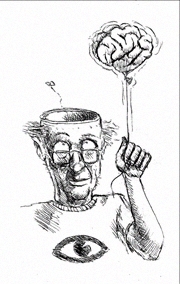Tutor HuntResources Art Resources
How To Really Create Something...
A brief introduction to the fine art of "Synectics" as taught to me
Date : 11/08/2012
Author Information

Uploaded by : Martin
Uploaded on : 11/08/2012
Subject : Art
He who masters metaphor is genius - (paraphrasing Aristotle). So what are the basic steps to Synectics? After all it sounds like something that you blow out your nose.
The first step is defining the problem. State in a simple sentence what the problem is all about or what you are trying to achieve. This doesn`t have to be anything great or creative at this step, it can be just another boring marketing message.
Then pose an evocative question to begin the process of finding analogies and metaphors. This "thing" or service is "like" something. The telephone circuits of the British phone service are "like" the arteries of the body. A building may have a similar shape or be "like" an ear of corn. There are a number of different analogies that you can draw from.
The goal here is to come up with as many analogies as you can. Do not pass judgment on them! The more obscure and obtuse the analogy is the more likelihood you will have of generating a good idea. When dealing with analogies, look for opposites. It is tempting when doing something for software or technology to try to do something "techy" or high tech. Go the opposite direction, organic, living, natural. Apple took this direction with their early graphics in the 80`s. IBM, etc., tried to look like "TRON" but Apple hired a zen calligrapher to give their logos and packaging a "human" quality.
The key is "free association". The conscious mind is unhooked from its steering and allowed to flow.
The analogies are usually broken down as follows: 1. Direct analogies - telephone network resembles the arteries of the human body. These are direct resemblances that are obvious. It can be color, shape or function. 2. Personal analogies - You "become" the product or service. What does a piece of trash or litter "feel" like when sitting by the side of the road? Alone, rejected, unloved? I can still remember the iconic commercial done in the sixties by illustrator R. O. Blechman where your stomach has a long discussion about why you are treating him so badly (it was for Alka Seltzer.) 3. Symbolic analogies - These are inherent paradoxes. Fire can be life giving and destructive as can storms. They bring warmth or much needed water but can also burn and destroy. There is a subset to this one. You see the fang marks from a snake, or a blood trail from a cut. You see the effect of wind moving in the trees but you never really "see" wind. They all imply something was there that made the wounds. This is the trickiest of the four, but perhaps the most rewarding one. 4. Fantasy analogies - What if the product were "magical" and possessed supernatural qualities? A car with smooth ride becomes a "magic carpet", etc.
There are MORE you will find in your research. I have one book that cites at least 14 methods of metaphor.
Once you have done some of this (in some cases a LOT of it for a project.) You are ready for the next step. The "Force Fit". If you have come up with some really far out analogies you will have to do some real mental gymnastics to make things fit into place. You are now bringing all the ideas back into the ranch, coralling all the rowdy little suckers and making them do some work.
If you can get a handle on doing "good ideas", styles will come and go, technologies are going to be changing at the speed of light, media outlets are going to die and be born, but the "concept" the "idea" will be king. It is the foundation of all "good" design.
This resource was uploaded by: Martin
